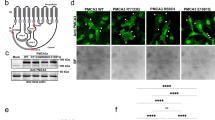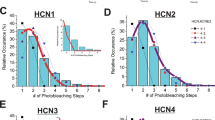Abstract
P-type and Q-type calcium channels mediate neurotransmitter release at many synapses in the mammalian nervous system. The α1A calcium channel has been implicated in the etiologies of conditions such as episodic ataxia, epilepsy and familial migraine, and shares several properties with native P- and Q-type channels. However, the exact relationship between α1A and P- and Q-type channels is unknown. Here we report that alternative splicing of the α1A subunit gene results in channels with distinct kinetic, pharmacological and modulatory properties. Overall, the results indicate that alternative splicing of the α1A gene generates P-type and Q-type channels as well as multiple phenotypic variants.
This is a preview of subscription content, access via your institution
Access options
Subscribe to this journal
Receive 12 print issues and online access
$209.00 per year
only $17.42 per issue
Buy this article
- Purchase on Springer Link
- Instant access to full article PDF
Prices may be subject to local taxes which are calculated during checkout






Similar content being viewed by others
References
McCleskey, E. W. & Schroder, J. E. Functional properties of voltage–dependent calcium channels. Curr. Top. Membr. 39, 295–326 ( 1991).
Huguenard, J. R. Low–threshold calcium currents in central neurons. Annu. Rev. Physiol. 58, 329–348 (1996).
Murphy, T. J., Worley, P. F. & Baraban, J. M. L-type voltage-sensitive calcium channels mediate synaptic activation of immediate early genes. Neuron 7, 625–635 (1991).
Bading, H., Ginty, D. D. & Greenberg, M. E. Regulation of gene expression in hippocampal neurons by distinct calcium signaling pathways. Science 260 , 181–186 (1993).
Turner, T. J., Adams, M. E. & Dunlap, M. E. Calcium channels coupled to glutamate release identified by ω-Aga-IVA. Science 258, 310– 313 (1992).
Takahashi, T. & Momiyama, A. Different types of calcium channels mediate central synaptic transmission. Nature 366, 156–158 (1993).
Regehr, W. G. & Mintz, I. M. Participation of multiple calcium channel types in transmission at single climbing fiber to Purkinje cell synapses. Neuron 12, 605–613 (1994).
Dunlap, K., Luebke, J. I. & Turner, T. J. Exocytotic Ca2+ channels in mammalian central neurons. Trends Neurosci. 18, 89 –98 (1995).
Stea, A., Soong, T. W. & Snutch, T. P. in Handbook of Receptors and Channels: Ligand- and Voltage-Gated Ion Channels (ed. North, R. A.) 113– 152 (CRC Press, Boca Raton, Florida, 1995).
Soong, T. W. et al. Structure and functional expression of a member of the low voltage-activated calcium channel family. Science 260 , 1133–1136 (1993).
Bourinet, E. et al. The α1E calcium channel exhibits permeation properties similar to low-voltage-activated calcium channels. J. Neurosci. 16, 4983–4993 (1996).
Williams, M. E. et al. Structure and functional characterization of neuronal α 1E calcium channel subtypes. J. Biol. Chem. 269 , 22347–22357 (1994).
Perez-Reyes, E. et al. Molecular characterization of a neuronal low-voltage-activated T-type calcium channel. Nature 391, 896– 900 (1998).
Lee, J.-H. et al. Cloning and expression of a novel member of the low voltage-activated T-type calcium channel family. J. Neurosci. 19, 1912–1921 (1999).
Llinas, R., Sugimori, M., Lin, J. W. & Cherksey, B. Blocking and isolation of a calcium channel from neurons in mammals and cephalopods utilizing a toxin fraction (FTX) from funnel-web spider poison. Proc. Natl. Acad. Sci. USA 86, 1689–1693 (1989).
Mintz, I. M. et al. P-type calcium channels blocked by the spider toxin ω-Aga-IVA. Nature 355, 827–829 (1992).
Mintz, I. M., Adams, M. E. & Bean, B. P. P-type calcium channels in rat central and peripheral neurons. Neuron 9, 85–95 (1992).
Zhang, J.-F. et al. Distinctive pharmacology and kinetics of cloned neuronal Ca2+ channels and their possible counterparts in mammalian CNS neurons. Neuropharmacology 32, 1075– 1080 (1993).
Randall, A. & Tsien, R. W. Pharmacological dissection of multiple types of Ca2+ channel currents in rat cerebellar granule neurons. J. Neurosci. 15, 2995– 3012 (1995).
Wheeler, D. B., Randall, A. & Tsien, R. W. Roles of N-type and Q-type Ca2+ channels in supporting hippocampal synaptic transmission. Science 264, 107–111 (1994).
Tottene, A., Moretti, A. & Pietrobon, D. Functional diversity of P-type and R-type calcium channels in rat cerebellar neurons. J. Neurosci. 16, 6353–6363 (1996).
Forsythe, I. D., Tsujimoto, T., Barnes-Davies, M., Cuttle, M. F. & Takahashi, T. Inactivation of presynaptic calcium current contributes to synaptic depression at a fast central synapse. Neuron 20, 797–807 ( 1998).
Mori, Y. et al. Primary structure and functional expression from complementary DNA of a brain calcium channel. Nature 350, 398–402 (1991).
Starr, T. V. B., Prystay, W. & Snutch, T. P. Primary structure of a calcium channel that is highly expressed in the rat cerebellum. Proc. Natl. Acad. Sci. USA 88, 5621–5625 (1991).
Stea, A. et al. The localization and functional properties of a rat brain α 1A calcium channel reflect similarities to neuronal Q- and P-type channels. Proc. Natl. Acad. Sci. USA 91, 10576– 10580 (1994).
Sather, W. A. et al. Distinctive biophysical and pharmacological properties of Class A (BI) calcium channel α1 subunits. Neuron 11, 291–303 ( 1993).
Ophoff, R. A. et al. Familial hemiplegic migraine and episodic ataxia type-2 are caused by mutations in the Ca2+ channel gene CACNL1A4. Cell 87, 543–552 ( 1996).
Fletcher, C. F. et al. Absence epilepsy in tottering mutant mice is associated with calcium channel defects. Cell 87, 607– 617 (1996).
Zhuchenko, O. et al. Autosomal dominant cerebellar ataxia (SCA6) associated with small polyglutamine expansions in the α1A–voltage-dependent calcium channel. Nat. Genet. 15, 62– 69 (1997).
Pragnell, M. et al. Calcium channel β subunit binds to a conserved motif in the I-II cytoplasmic linker of the α1 subunit. Nature 368, 68–70 ( 1994).
Babitch, J. Channel hands. Nature 346, 321– 322 (1990).
Zamponi, G. W. & Snutch, T. P. Modulation of voltage-dependent calcium channels by G proteins. Curr. Opin. Neurobiol. 8, 351–356 ( 1998).
Bean, B. P. Neurotransmitter inhibition of neuronal calcium channels by changes in channel voltage dependence. Nature 340, 153– 156 (1989).
Stea, A., Soong, T. W. & Snutch, T. P. Determinants of PKC-dependent modulation of a family of neuronal calcium channels. Neuron 15, 929–940 (1995).
Yang, J., Ellinor, P. T., Sather,W. A., Zhang, J. F. & Tsien, R. W. Molecular determinants of Ca2+ selectivity and ion permeation in L-type Ca2+ channels. Nature 366, 158–161 (1993).
Nakai, J., Adams, B. A., Imoto, K. & Beam, K. G. Critical roles of the S3 segment and S3–S4 linker of repeat I in activation of L-type calcium channels. Proc. Natl. Acad. Sci. USA 91, 1014–1018 (1994).
Zhang, J.-F., Ellinor, P. T., Aldrich, R. W. & Tsien, R. W. Molecular determinants of voltage-dependent inactivation in calcium channels. Nature 372, 97–100 (1994).
Tanabe, T., Beam, K. G., Adams, B. A., Niidome, T. & Numa, S. Region of the skeletal muscle dihydropyridine receptor critical for excitation-contraction coupling. Nature 346, 567–569 (1990).
McDonough, S. I., Mintz, I. M. & Bean, B. P. Alteration of P-type calcium channel gating by the spider toxin ω-Aga-IVA. Biophys. J. 72, 2117–2128 (1997).
Rogers, J. C., Qu, Y., Tanada, T. N., Scheuer, T. & Catterall, W. A. Molecular determinants of high affinity binding of α-scorpion toxin and sea anemone toxin in the S3–S4 extracellular loop in domain IV of the Na+ channel α subunit. J. Biol. Chem. 271, 15950–15962 ( 1996).
Cestele, S. et al. Voltage sensor trapping: enhanced activation of sodium channels by β-scorpion toxin bound to the S3–S4 loop in domain II. Neuron 21, 919–931 ( 1998).
Swartz, K.J & MacKinnon, R. Mapping the receptor site for hanatoxin, a gating modifier of voltage-dependent K+ channels. Neuron 18, 675–682 (1997).
Li-Smerin, Y. & Swartz, K. J. Gating modifier toxins reveal a conserved structural motif in voltage-gated Ca2+ and K+ channels. Proc. Natl. Acad. Sci. USA 95, 8585–8589 (1998).
Herlitze, S., Hockerman, G. H., Scheuer, T. & Catterall, W. A. Molecular determinants of the inactivation and G protein modulation in the intracellular loop connecting domains I and II of the calcium channel α 1A subunit. Proc. Natl. Acad. Sci. USA 93, 1512–1516 (1997).
Berrow, N. S., Brice, N. L., Tedder, I., Page, K. M. & Dolphin, A. C. Properties of cloned rat α1A calcium channels transiently expressed in the COS-7 cell line. Eur. J. Neurosci. 9, 739–748 ( 1997).
Buller, A. L. & White, M. M. Altered patterns of glycosylation of the Torpedo acetylcholine receptor expressed in Xenopus oocytes. J. Membrane Biol. 115, 179– 189 (1990).
Westenbroeck, R. E. et al. Immunochemical identification and subcellular distribution of the α1A subunits of brain calcium channels. J. Neurosci. 15, 6403–6418 (1995).
Brody, L. D., Patil, P. G., Mulle, J. G., Snutch, T. P. & Yue, D. Y. Burst of action potential waveforms relieve G-protein inhibition of recombinant P/Q-type Ca2+ channels in HEK 293 cells. J. Physiol. (Lond.) 499, 637–644 (1997).
Ligon, B., Boyd, A. E. III & Dunlap, K. Class A calcium channel variants in pancreatic isets and their role in insulin secretion. J. Biol. Chem. 273, 13905–13911 (1998).
Yu, A. S., Herbert, S. C., Brenner, B. M. & Lytton, J. Molecular characterization and nephron distribution of a family of transcripts encoding the pore-forming subunit of Ca2+ channels in the kidney. Proc. Natl. Acad. Sci. USA 89, 10494– 10498 (1992).
Acknowledgements
We thank M. Gilbert and A. Stea for comments, E. Perez-Reyes for β2a and β4 subunit cDNAs, and M. Ahlijanian (Pfizer) for ω-agatoxin IVA. T.W.S. was supported by a fellowship from the University of Singapore, Institute of Molecular Biology, E.B. by fellowships from INSERM and EMBO, K.S. by a grant from the Amytrophic Lateral Sclerosis Society of Canada, G.W.Z .by a grant from the Medical Research Council (MRC) of Canada and scholarships from MRC and the Alberta Heritage Foundation for Medical Research. E.B. and G.W.Z. are supported by NATO grant (CRG 971546) and T.P.S. is supported by a grant from the MRC of Canada and an MRC Scientist award.
Author information
Authors and Affiliations
Rights and permissions
About this article
Cite this article
Bourinet, E., Soong, T., Sutton, K. et al. Splicing of α1A subunit gene generates phenotypic variants of P- and Q-type calcium channels. Nat Neurosci 2, 407–415 (1999). https://doi.org/10.1038/8070
Received:
Accepted:
Issue Date:
DOI: https://doi.org/10.1038/8070
This article is cited by
-
Phenotypic analysis of ataxia in spinocerebellar ataxia type 6 mice using DeepLabCut
Scientific Reports (2024)
-
Structural basis for different ω-agatoxin IVA sensitivities of the P-type and Q-type Cav2.1 channels
Cell Research (2024)
-
Prolonged neurologic deficits with brain MRI changes following ECT in an adolescent with a CACNA1a-related disorder; a case report
BMC Neurology (2022)
-
Targeting voltage-gated calcium channels in neurological and psychiatric diseases
Nature Reviews Drug Discovery (2016)
-
Rôle des canaux calciques de type T dans les douleurs neuropathiques
Douleur et Analgésie (2016)



